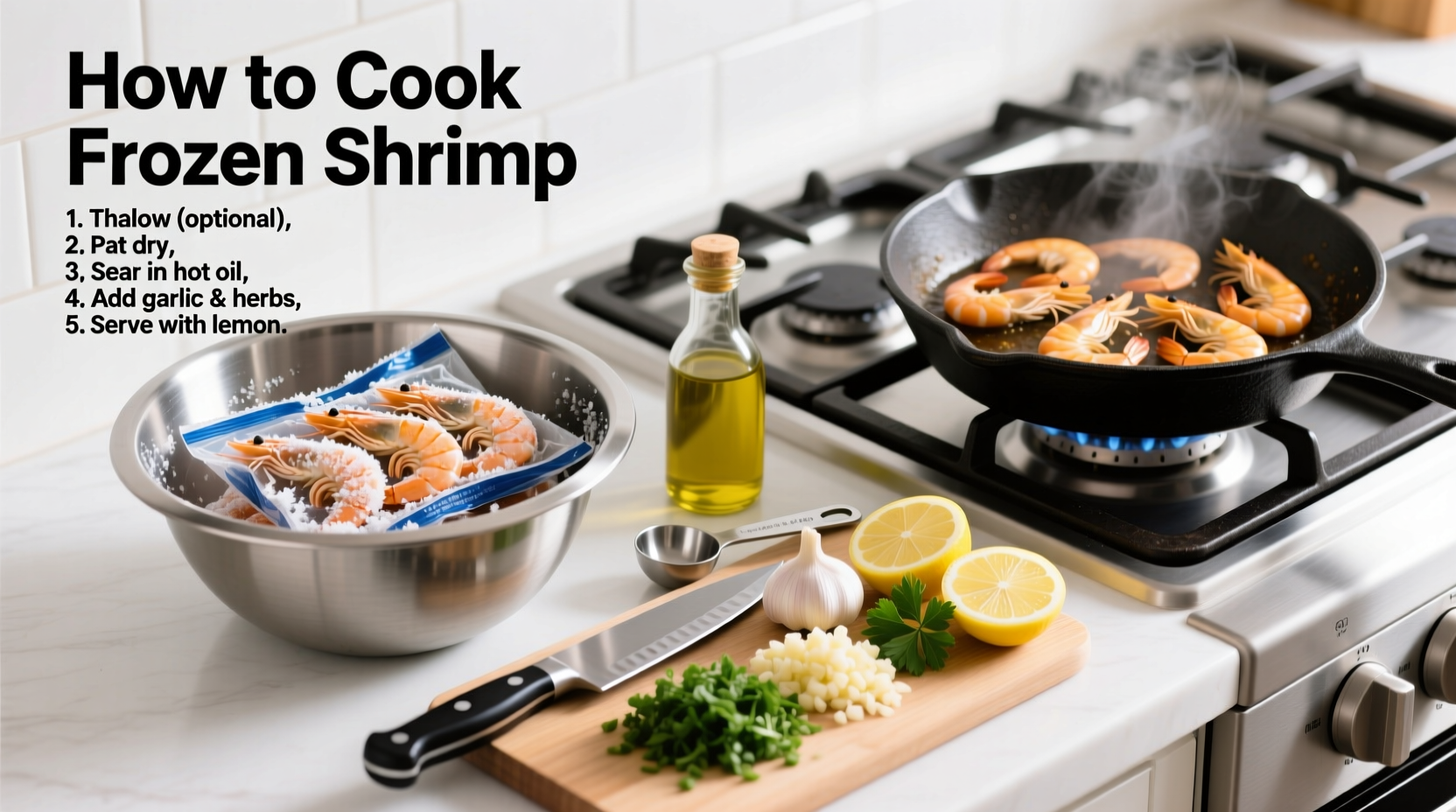Many home cooks waste precious time thawing shrimp when they could be creating restaurant-quality dishes in minutes. As a professional chef who's cooked thousands of pounds of shrimp, I've perfected methods that transform frozen seafood into tender, flavorful meals without the wait. This guide reveals exactly how to cook frozen shrimp properly using techniques backed by food science and culinary expertise.
Thawing vs. Cooking From Frozen: What Science Says
Contrary to popular belief, thawing shrimp often leads to waterlogged, rubbery results. When frozen shrimp thaw slowly in the refrigerator or at room temperature, ice crystals melt and escape the muscle fibers, causing the shrimp to absorb excess water. This compromises texture and makes proper searing impossible.
| Method | Time Required | Texture Outcome | Best Cooking Methods |
|---|---|---|---|
| Refrigerator Thawing (12+ hours) | 12-24 hours | Waterlogged, less firm | Boiling, steaming |
| Cold Water Thawing (20-30 min) | 20-30 minutes | Moderately firm | Pan-searing, grilling |
| Cooking Directly From Frozen | 5-15 minutes | Firm, restaurant-quality | Skillet, oven, air fryer |
Research published in the Journal of Food Science confirms that cooking shrimp directly from frozen preserves more natural juices and yields superior texture. The FDA's Safe Food Handling Guidelines also verify that cooking seafood from frozen is safe when proper internal temperatures are reached.
Your Step-by-Step Guide to Perfect Frozen Shrimp
Preparation: Setting Up for Success
Before touching your shrimp, gather these essentials:
- Heavy-bottomed skillet or cast iron pan (critical for proper searing)
- High smoke-point oil (avocado, grapeseed, or refined coconut)
- Instant-read thermometer (the only reliable doneness indicator)
- Paper towels (for moisture control)
Remove frozen shrimp from packaging and place in a single layer on paper towels. Gently press additional towels on top to absorb surface ice crystals—this prevents steaming instead of searing. Season lightly with salt just before cooking; salt draws out moisture if applied too early.
Cooking Methods That Actually Work
Skillet Searing (Best for Flavor)
Heat 1 tablespoon oil in your skillet over medium-high heat until shimmering (about 350°F). Add shrimp in a single layer without crowding. Cook undisturbed for 2-3 minutes until golden brown on first side, then flip and cook 1-2 minutes more. The shrimp should curl into a loose 'C' shape when perfectly cooked.
Oven Roasting (Best for Large Batches)
Preheat oven to 425°F with rack in upper third. Toss frozen shrimp with 1 tablespoon oil and seasonings on a parchment-lined baking sheet. Roast 12-15 minutes, flipping halfway, until opaque throughout. This method prevents the uneven cooking common with thawed shrimp.
Air Frying (Best for Crispy Results)
Preheat air fryer to 400°F. Toss frozen shrimp with 1 teaspoon oil and arrange in single layer. Cook 8-10 minutes, shaking basket halfway through. The circulating hot air creates a texture similar to deep-fried without excess oil absorption.

Avoiding the #1 Mistake: Overcooking
Shrimp cook faster than most proteins and continue cooking after removal from heat. The critical doneness indicators:
- Visual cue: Opaque white/pink with no gray translucency
- Shape: Forms a loose 'C' (tight 'O' means overcooked)
- Internal temperature: 145°F (63°C) at thickest part
When cooking from frozen, reduce standard cooking times by 25%. For example, if recipe says 3 minutes per side for thawed shrimp, cook frozen shrimp 2-2.5 minutes per side. Remember that carryover cooking adds 2-3 minutes of residual heat exposure.
Pro Flavor Boosters That Make a Difference
Elevate your frozen shrimp with these chef-recommended techniques:
- Dry brine before cooking: Toss with ½ teaspoon kosher salt per pound and rest 15 minutes (even on frozen shrimp) for better moisture retention
- Acid balance: Finish with lemon or lime juice—never add citrus before cooking as it denatures proteins prematurely
- Aromatics timing: Add garlic and ginger in last 60 seconds to prevent burning
- Butter baste: Swirl in cold butter during final minute for restaurant-quality sheen
For Cajun-style shrimp, mix spices with 1 teaspoon oil before coating frozen shrimp—this prevents clumping that happens with dry spice application on icy surfaces.
Serving Suggestions That Impress
Pair your perfectly cooked frozen shrimp with these complementary elements:
- For pasta dishes: Toss with linguine, garlic, chili flakes, and a splash of pasta water to create instant sauce
- For salads: Cool slightly before adding to greens to prevent wilting
- For tacos: Add to warm tortillas with crisp cabbage and avocado crema
- For appetizers: Skewer with lemon wedges and fresh herbs
Remember that frozen shrimp often has higher moisture content than fresh, so pat dry thoroughly before adding to cold preparations like ceviche or salads.
Troubleshooting Common Issues
Problem: Shrimp steaming instead of searing
Solution: Ice crystals are melting too quickly—dry shrimp more thoroughly with paper towels and ensure pan is properly preheated
Problem: Uneven cooking with some pieces overdone
Solution: Shrimp sizes vary—sort by size before cooking or adjust placement in pan (larger pieces toward center heat)
Problem: Rubbery texture despite proper timing
Solution: Check shrimp type—some frozen shrimp contains sodium tripolyphosphate (STPP) which alters texture; look for "no additives" on packaging











 浙公网安备
33010002000092号
浙公网安备
33010002000092号 浙B2-20120091-4
浙B2-20120091-4